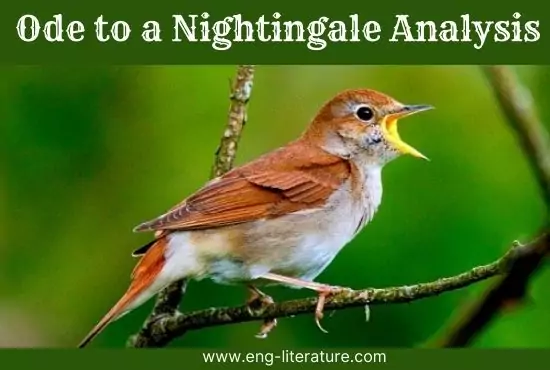Ode to a Nightingale Critical Appreciation
Ode to a Nightingale is one of the noblest achievements of Keats’s genius. It was inspired by the joyous song of a nightingale he actually heard. It reveals almost all the dominant characteristics of Keats’s poetry.
Keats’s poetry is abundantly and enchantingly sensuous. He himself said, “O for life of sensations rather than of thoughts.” Unlike Shelley he loved to revel in the luxury of the senses, even of those associated with sex or feminine body. The Ode to a Nightingale begins with the record of a sensation which it purely physical. The poet has drunk in the music of the nightingale’s song until his whole being is charged with it and gives way to a sort of narcotic influence due to the excess and intensity of joy.
Also Read:
Then to rouse himself from the dreamy torpor he longs for a draught of wine that has been cooled underground for a long time. But with Keats wine brings with it an opportunity for indulging in a luxury of sensations. The description of wine in the following lines is instinct with sensuousness
“O for a beaker full of the warm South
Full of the true, the blushful Hippocrene,
With beaded bubbles, winking at the brim,
And purple-stain’d mouth.”
The whole fifth stanza is a riot of sensuous enjoyment. It appeals to the senses all at once. The bower of the nightingale is dark, but filled with perfume. Though the poet cannot see what flowers are at his feet or what blossoms are above his head, he can guess from the scent that the white hawthorn, the eglantine, the violet and the muskrose are blooming there.
The Ode is not only intensely sensuous but deeply reflective. It turns on the thought of the conflict between the ideal and the real-between the joy beauty and apparent permanence of the nightingale’s song, and the sorrow and transience of joy and beauty in human life, which lends a deep philosophic interest to it. The poet is still sensuous, but his sensuousness is now touched with the still, sad music of humanity”, and shot through and through with the stirrings of an awakening intellect.
The poem vibrates with personal anguish. The youth that grows pale, and spectre-thin and dies is his own brother Tom Keats who died five months before the poem was written. Beauty’s lustrous eyes are Fanny Brawne‘s and the new love that cannot “pine at them beyond tomorrow” refers to his own love that has already become an agony. But though the poem is tense with personal anguish, it would not be wise to call it a poem of despair.
As Middleton Murry says,
“Its marvel is that it holds suspended, in a moment of absolute beauty, the tension between Time and Eternity, between Joy and Sorrow, between Mortality and Immortality, between Life and Death. It denies nothing of human experience, and it makes a great affirmation; that…..the bitterest human experience, if it can be so contemplated by the imagination, turns, or can be transmuted into the beauty which is truth.” (Keats)
Among the other elements of Keats’s poetry the Ode illustrates are his love of romance, deep delight in nature and Hellenism. The voice of the nightingale is the voice of romance and beauty, a voice that is deathless, in a world where beauty is evanescent and romance fleeting.
The whole spirit of medieval romance and chivalry is crystallized in the poet’s passing reference to the forlorn princess imprisoned in an enchanter’s castle and waiting for her Knight to come to deliver her. The description of the woodland scene is rich and vivid and the references to Lethe, Flora, Dryad, Hippocrene, Bacchus, etc, demonstrate how the Greek mythology appealed to him.
Also Read:
The poem is remarkable for that “rounded felicity of expressions” which is as Matthew Arnold remarks, truly Shakespearean. Such expressions as “verdurous gloom”. “embalmed darkness’, “full-throated ease”, “purple-stained mouth”. etc. show the high water-mark of verbal perfection and of the concretization of imagery. The deep suggestiveness of the lines
“Charmed magic casements opening on the foam
Of perilous seas in faery lands forlorn.”
is unparalleled in the whole range of English poetry. As we read the passage we catch a vast vista of medieval times with the shadowy enchanter’s castle in a kingdom by the sea, the lonely tower of which encloses an imprisoned princess. The passage is a wonderful example of perfect word-painting Rossetti says:
“It (the passage) shows a reach of expression which might almost be called the pillars of Hercules of human language. Far greater things have been said by greater minds, but nothing more perfect in form has been said—nothing wider in scale and closer in utterance-by any mind of whatsoever pitch of greatness.”
The description of a beaker of wine with “beaded bubbles winking at the brim” and “purple-stained mouth” is another instance of marvellous verbal pictures that fill the poem.
The leisurely, rhythmical movement of the verse, as well as the melody of the words makes the poem a jet of music like the song it celebrates. Prof. Hales rightly observes that Keats’s song, as one hears it is like that of the nightingale as he heard it.

Hello, Viewers! Besides being the Founder and Owner of this website, I am a Government Officer. As a hardcore literary lover, I am pursuing my dream by writing notes and articles related to Literature. Drop me a line anytime, whether it’s about any queries or demands or just to share your well-being. I’d love to hear from you. Thanks for stopping by!

It is useful website thanks
Thanks a lot